
Doom
Written by: Rik
Date posted: June 13, 2015
- Genre: Action
- Developed by: id Software
- Published by: id Software
- Year released: 1993
- Our score: 7
Few games provoke such frequent and fond reminiscences as id Software’s Doom, and in keeping with the tradition of harking back to the early to mid 90s for some relevant memories, I’ll begin by sharing my own. In 1993, the sole source of gaming content in my house was an Atari ST, the software base of which was rapidly diminishing, to the extent that the meagre handful of Amiga titles actually given an ST release were seized upon with pathetic gratitude. When, two years later, the home computer was replaced and we finally had a DOS machine to call our own, Doom was still everywhere: Doom II, Doom clones, Doom maps, Doom editors, rumours of new Doom games…it was Doom, Doom and more flippin’ Doom.
Frankly, I found it all a bit much. Nevertheless, a shareware copy of the game was one of the first things installed on the new PC when it arrived, and there was a certain excitement attached to seeing and experiencing it for myself. It looked and sounded great, and as a demonstration of technical superiority over the 16-bit consoles and the Amiga, it certainly did the trick. But that initial excitement soon fizzled out, and I didn’t actually play it for very long at all.
Critical acclaim for Doom had been almost universal, although one of the few dissenting voices came from the UK multi-format poncefest Edge, whose lukewarm appraisal featured a now infamous statement about the game’s numerous enemies:
“If only you could talk to these creatures, then perhaps you could try and make friends with them, form alliances… Now, that would be interesting.”
It’s a line that has been quoted, misquoted, and roundly mocked ever since, but in a way it sort of cuts to the core of my main problem with Doom: it was ‘just’ a shooter. A bigger, nicer-looking and more technically accomplished shooter than had ever been seen before, admittedly, but not something that otherwise represented a great step forward. Sure, the technology was good, but it somehow seemed like a waste. By contrast, I admired the ambition of a game like System Shock, and liked the idea of playing it, although in truth Shock was a little too complicated for me, and it sat on my shelf largely untouched (but serving the important purpose of making me feel like the kind of guy who would prefer it to Doom if he had actually played Doom and System Shock for long enough to make the comparison).
Hence, a timely write-up for FFG was never going to be on the cards – from me, at least (my friend and colleague Stoo has more of a taste for 90s shooters, but Doom wasn’t high on his list either). The occasional bit of dabbling aside, my FPS career started a bit later, with the mighty Half-Life, a game I really could get excited about, because by adding narrative elements, it really did seem to move the genre forward, completely drawing you into another world and an unfolding story, told in first-person. Finally, all the blasting had some sort of context. (You still couldn’t talk to the monsters, though).
Had I been minded to produce a review of Doom at any point in the site’s early years, I almost certainly would have made unfavourable comparisons with Half-Life, along the lines that FPS games had immeasurably changed for the better since H-L, and there was absolutely no point in going back to your silly DOS shooters. For all kinds of reasons, I’m glad I didn’t, and more recently, I’ve started to wonder whether any kind of comparison is valid at all. Since Half-Life, the trend for the single-player element of the modern FPS – the Call of Dutys of this world – is to do your shooting while being carried through a series of scripted events, herded along a linear path in order to observe them as intended. Even Doom 3 made concessions to the Half-Life template with an extended first person preamble instead of throwing you straight into the action.
Doom, on the other hand, calls to mind the name of one of the first ever first person games: 3D Monster Maze on the ZX81. Doom is, basically, a 3D monster maze – and you still have to find the exit, but instead of running away, you get a gun (or two). When compared to more recent FPS games, it is set apart by a clarity of purpose, and – I hesitate to use the word – purity that all of a sudden seems rather refreshing. And so, by virtue of doing absolutely nothing at all, a game that I once might have lazily dismissed as dated and passé now seems distinctive and relevant, making the prospect of a belated Doom review a more appealing one. (Of course, I refer here only to my own thought processes: in the general gaming consciousness, I’m not sure that Doom’s star has ever really dimmed much at all).
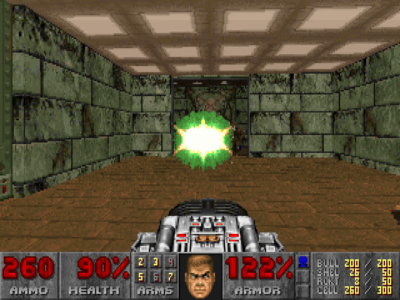
Doom’s biggest gun – the BFG 9000 – being tested out on a wall. (Maybe there’s a baddie under there, I don’t know. Let’s say there is.)
There’s the context for retro fans, long term readers of the site (if, indeed they exist) and anyone who knows what Doom is already. For everyone else: Hello! I’m Rik and today I will be reviewing an old game called Doom. I have been told that it might be interesting for someone with little previous experience of, or residual fondness for, this famous and hugely successful game to write up his thoughts, but if you really want comprehensive coverage from someone who knows what they’re talking about then you should probably go elsewhere (might I recommended our good friends at Just Games Retro?)
To start with an extremely rough and ready timeline, Doom sits relatively early in the evolution of first-person shooters, between two of id’s other titles, Wolfenstein 3D and Quake, and some five years before the release of Half-Life. The engine is a clear leap forward from Wolf 3D, which was pretty much set in a series of boxy rooms and plain corridors. In comparison, Doom features much more complex architecture, with stairs, lifts and platforms expanding the possibilities for more nuanced level design, although staple features of future FPS games such as the ability to jump, and look up and down, were still absent at this point. ‘Mouse look’ does feature, though most of the looking will be to the left or right, and when battling any enemies on a higher or lower level, Doom will assist your aim accordingly (with, it has to be said, mixed results).
In terms of setup, as we alluded to earlier, there’s been less significant progress, with no flashy intro, cut-scenes, or anything much in the way of story. Essentially, you’re a space marine who is the last to arrive at a party that has gone very badly wrong. The forces of hell have taken over your base, and in order to survive, you must kill absolutely everything that moves. After battling through the shareware episode, Knee Deep in the Dead, you’ll progress to a second Martian base (The Shores of Hell) more deeply afflicted by sinister otherworldly forces, and then to hell itself (Inferno) for the final levels. Plot details, such as they are, are relayed via a series of text screens at the end of each episode. Despite receiving minimal emphasis, it does all at least make some sense, and there is a feeling of progression through the different environments. In my head, the Doom levels were made up of a random selection of chopped up and interchangeable textures and enemies flung together for no particular reason – perhaps this was more the case with Doom II or was just an unfair recollection on my part: if so, it was one of many that I’ve been carrying around with me all these years.
I was actually surprised just how little did seem familiar. Other than the opening level of the first episode and its whapa-pamppamppamppamp-bada whapa-pamppamppamp-wow music, only occasional snippets – the names of the difficulty levels, the sassy faux-macho posturing of the exit to DOS prompt, shooting barrels near baddies to reduce them to smouldering piles of flesh, and a fear of those big pink dog things that charge at you (I never did know the proper names of all the enemies, instead ascribing them unimaginative appearance-based descriptions: green hair, bald head shotgun, brown spiky fireball etc.) – had any real resonance. I have to say that the last of those was the most evocative of my early Doom experiences, and the weird growling noise that alerts you to the fact that one (or more) is on the prowl nearby, is as unsettling now as it was back then.
Doom makes very good use of sound – and light – to build tension and give you the odd scare. Levels are full of tricks and traps, too, and as you explore in an attempt to find a key, an exit, or some goodies, there’s always a chance you could be heading for trouble. Items left seemingly unguarded are increasingly likely to be bait, but on the other hand, you might really need them, so it’s often a case of balancing risk and reward (and you can always reload a save if you change your mind). The combat itself can be frenetic, but also clinical – monsters that can absorb ridiculous amounts of firepower are few and far between, and when they do appear, they’re used sparingly. Weapons all have their uses – except maybe the pistol – and the trusty shotgun is your friend, especially at close quarters. Even the chainsaw, something I previously dismissed as a bit of a useless gimmick, has a genuine use – it’s really good for cutting up those pink doggies [oh, for God’s sake – they’re called ‘demons’ – FFG reader], especially in a narrow corridor. At the top end of the scale, rockets and other projectiles are best saved for when you’re seriously outnumbered, or facing a big boss baddie.
Pacing is nice and tight – the action is fairly relentless, and you certainly feel like a one man killing machine, battling the odds in unfamiliar and unsettling circumstances. There is a little bit more wandering around aimlessly, getting lost and searching for keys towards the end, but for the most part, the demon-blasting doesn’t let up. And, as previously mentioned, despite a lack of story exposition, the action does form a coherent whole in a way that I’d never really recognised before, although the discrete, stand-alone nature of the episodes undermines this slightly: upon completing one, you have to go to the menu to select the next, and begin with nothing more than a pistol to your name, as if you hadn’t even bothered to complete the others (and indeed, there’s absolutely no requirement to do so – you can go straight to whichever one you like from the very first time you boot the game up).
One thing in Doom’s favour that became apparent to me over time is that the blowing away of wave upon wave of monsters in order to survive is actually a reasonable explanation of the otherwise bloodthirsty FPS model. When the genre started to be transposed to modern day, somewhat less fantastical scenarios, the player was faced with gunning down human enemies, in place of slightly daft-looking cartoon aliens. Now, everyone is familiar with the action film cliché of numerous faceless henchmen being killed, but such were the requirements of a decent-length FPS, the numbers involved started to get a bit ridiculous. Post Half-Life shooters like 007: Nightfire and Die Hard: Nakatomi Plaza must have seemed like great opportunities to spin off successful movies, but the mammoth bodycount, not to mention ludicrous bullet-sponge enemies, often with poor AI, sort of meant the experience didn’t really ring true. In Doom, though, such things don’t matter.
Anyway, I cheerfully played through the first three episodes that made up the original game, and came away with a strong sense of Doom‘s strengths and merits, many of which I had not previously understood or recognised. However, the only version you can buy commercially these days is The Ultimate Doom, which comes with a fourth episode, Thy Flesh Consumed. Added in 1995, after the release of Doom II, there’s a notable difference in style and difficulty level which seems out of step with the main game. (My decision to stick it on ‘Hurt Me Plenty’ and see how I got on had been working fine for me up to this point).
I’ll be honest – Thy Flesh Consumed wasn’t for me, and it took me back to the niggles and annoyances of my 90s history with Doom, a time when its legions of fans craved more maps, but others had probably seen enough. Part of the motivation for The Ultimate Doom was to give Doom a boxed commercial release – it had previously only been distributed through the shareware model – and I guess they wanted to offer something extra for fans and completists.
I can’t speak to the quality of the maps – other than to say that I gave up on the whole thing after the second one – but I do remember PC Zone, a magazine so obsessed with id games that it devoted 16 pages to a Quake review (and, in a notable low point in the magazine’s history, weighed into the Quake vs Duke Nukem 3D debate by suggesting that those complaining that the former wouldn’t run on their PC only ever used their machine for downloading pictures of naked men from the internet) not being massively impressed, awarding it a score of 20%.
Much of that was probably down to the fact that Doom fans were being asked to shell out £30 just for an extra episode, which isn’t a consideration these days, and brief and unscientific internet research suggesting that Thy Flesh Consumed does have some fans. The fact that I’m not among them is probably indicative of my general tolerance for Doom, with my appetite being more than sated by the first three episodes that were present in the original release. Having said that, I did rather enjoy my time with Doom: it holds up rather well, and I’d certainly recommend it to anyone with an interest in shooters who hasn’t gone back to give it a go – particularly stubborn long-term holdouts like myself.

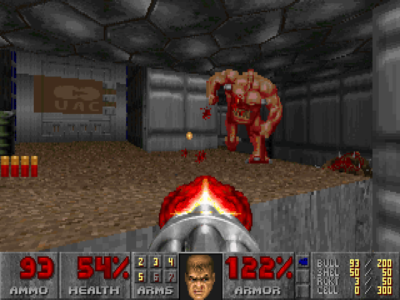
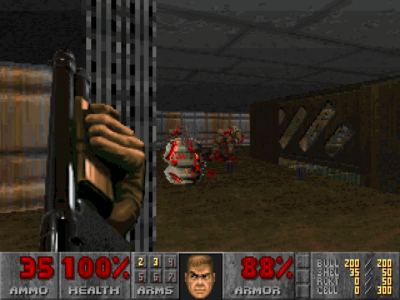
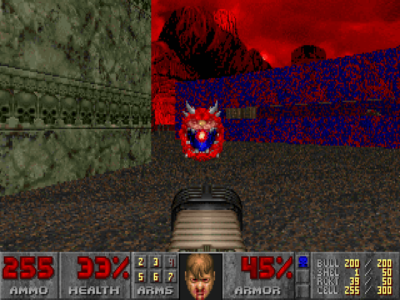
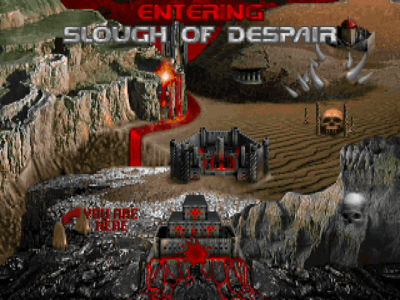
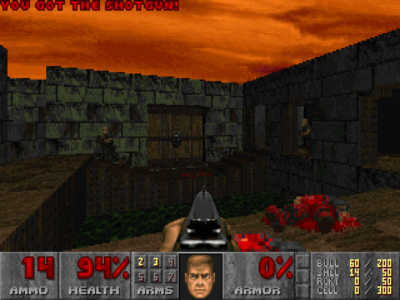

 Posts
Posts
Thanks for this one! It was indeed an interesting read, and I’m mostly glad that all my rambling years ago came to similar conclusions. Expertly balanced difficulties means it’s as action heavy or cautious and challenging as you want it to be, and it remains the rare game where difficulty means overwhelming numbers of cannon fodder, not turning regular enemies into bullet sponges.
It’s especially interesting to read in light of Doom 4’s announcement. I feel like Doom 4 is starting another one of those “what IS Doom, really?” arguments, and it seems blatant to me that 4 is trying to split the difference with the environments of 3, and the action of what they think 1 provided.
June 19, 2015 @ 8:35 pm
Incredible read, mate. Considering all the sealed boxed copies i have and the dozens of posters tucked up in my drawers, i consider myself a fan of DOOM. The simplistic ideology and excelent execution in both gameplay and ambiental display (graphical and musical) are enough to prove that in some cases, you can make more with less.
About the annoucement of DOOM 4. I agree with you sir, J Man, about idSoftware trying to bring the “action” back. It’s difficult to explain but i didn’t feel as excited for the game as i probably should. It is a much needed reboot but the gameplay trailer didn’t show anything i could find satisfying, not even the finisher moves (which are a problem of it’s own). What made DOOM back in-the-day wasn’t the violence and gore, but the pure fun it provided. Quite frankly, you could swap the demons for anything else and it would still be as much enjoyable (hell, i have Chex Quest and IT IS as much enjoyable).
Of course, if the Shadow Warrior reboot worked amazingly well, then there’s hope for this one too.
June 22, 2015 @ 3:39 pm
Actually, I believe, Thy Flesh Consumed was available for owners of the full version with a free patch, but I might be wrong here.
May 14, 2016 @ 9:17 pm
I’m not sure, either, but I certainly remember that the debate in games magazines over here was about whether The Ultimate Doom was all a big cash-in or not. I suppose even if it was the case that Thy Flesh Consumed had been made available to registered users, there was still an element of cynicism in a full-price boxed re-release of Doom anyway.
(p.s. fixed the score on Doom 3 – thanks!)
May 15, 2016 @ 4:54 pm